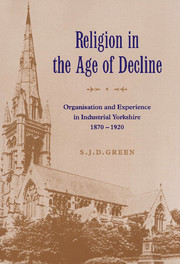Book contents
- Frontmatter
- Contents
- Acknowledgements
- List of tables
- List of abbreviations
- Introduction
- Part I Providing the means
- 1 The environment and its constraints: economic revolution, social transformation and spatial evolution
- 2 The many houses of God: churches, church building and church extension in the industrial town
- 3 The burden shared: the changing political economy of religious organisations
- Part II Drawing in the people
- Part III The trials of the religious life
- Conclusion
- Bibliography
- Index
2 - The many houses of God: churches, church building and church extension in the industrial town
from Part I - Providing the means
Published online by Cambridge University Press: 08 October 2009
- Frontmatter
- Contents
- Acknowledgements
- List of tables
- List of abbreviations
- Introduction
- Part I Providing the means
- 1 The environment and its constraints: economic revolution, social transformation and spatial evolution
- 2 The many houses of God: churches, church building and church extension in the industrial town
- 3 The burden shared: the changing political economy of religious organisations
- Part II Drawing in the people
- Part III The trials of the religious life
- Conclusion
- Bibliography
- Index
Summary
Introduction: the modern ecclesiastical landscape and the Victorian church-building boom
Any visitor travelling to Halifax, Keighley and Denholme today cannot but be struck by the number and grandeur of their churches. There are probably more than one hundred standing scattered around these three towns. And many of them are magnificent sights. No modern secular building, no factory, certainly no rail or road terminal can match the ornate splendour of All Souls', Haley Hill, in the north-east of Halifax. Closer into town, Ebenezer Primitive Methodist Church still dominates the new, western, centre just as St John the Baptist Parish Church presides over the old valley bottom. Watching over them all, perched seemingly precariously near the moorland on the hills to the east, sits St Thomas's, Claremount. Driving north towards Keighley, the same traveller will inevitably come across the isolated glory of St Peter's Church of England, Denholme, stuck out on its own half a mile from the main residential part of the village, and towering above everything else in an otherwise colourless local landscape. Finally, entering Keighley from the south, he will pass by the dignified serenity of St Andrew's Parish Church, then make his journey down North Street to St Anne's Roman Catholic Church. On his way, he will surely notice, just up the slopes to the west is Devonshire Street United Reform Church. As he leaves, he may observe, on his right, the Friends' Meeting House.
These are not just isolated sacred spots in an otherwise profane landscape.
- Type
- Chapter
- Information
- Religion in the Age of DeclineOrganisation and Experience in Industrial Yorkshire, 1870–1920, pp. 87 - 129Publisher: Cambridge University PressPrint publication year: 1996



